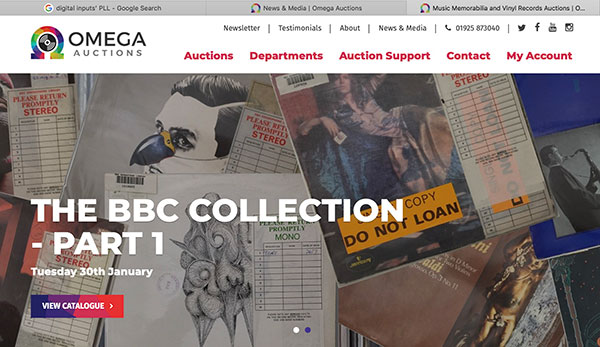Storage stories

When you’ve got a million records, some of them might have to go. In January the BBC began a series of online auctions to dispose of unwanted vinyl from its fabled record library. In a tweet, Omega Auctions said it had spent a productive few days clearing out thousands of LPs from the BBC’s archive. You wonder whether this was just another job to them, or whether they thought they’d died and gone to heaven.
Headliners included The Man Who Sold The World in its original cover with Bowie wearing a dress and with the misspelling ‘Tonny’ Visconti on the label. Less valuable discs were assembled by genre or label into lots ranging from a handful to a hundred. You could have acquired a bumper bundle of Deutsche Grammophons at less than £1 each.
On The Move
Yet the BBC’s vinyl archive ‘is very much still intact’ according to Omega. ‘This is largely the duplicate copies of LPs – so that the collection can be moved and better stored for the future.’ In fact, the BBC’s collection has moved several times, outgrowing a series of locations. Throughout the 1950s the Gramophone Library, as it was called then, was in Western House (since renamed Wogan House) in London’s Great Portland Street. In 1963, though, it moved to Egton House, adjacent to Broadcasting House.
A black-and-white newsreel from that year has Michael Aspel explaining the move. ‘Every disc issued by the major companies is automatically bought... The BBC pays for them. There’s no question of just using review copies. Those, and all superfluous copies, are sent to hospitals.’
However, in the 1960s and ’70s, with the record business booming, it became less feasible to buy every one that came out. In 1983, librarian Derek Lewis stated that the BBC was buying about 450 non-classical LPs and 250 singles each month, adding: ‘this is not the entire output of the British record industry by any means’.
The Gramophone Library moved again to join what was becoming a vast film and video archive in Windmill Road, Brentford. But the building there became increasingly unfit for purpose with flooding and other problems, so finally, in 2011, the new purpose-built BBC Archive Centre in Perivale was opened. This soon held 180,000 78s, 400,000 vinyl LPs, 350,000 CDs, around 2.7 million videotapes and 600,000 film components. The migration of all 3.8 million items had taken 200 days, with roughly 300 crates shifted each day – a far cry from the four days needed to move the entire contents of the Gramophone Library in 1963.
Meanwhile, as you’d expect, the BBC’s digitisation operations gathered pace, notably preserving content that’s on fragile film or video media. Although the BBC collections still fulfil the function of supplying the programme makers with the content they request, it’s really about preserving the heritage – give or take the odd episode of Doctor Who accidentally thrown in the bin.

King Of Collectors
Technology has sure moved on from the old mode of taking down a disc from a shelf, packing it up and sending it off, maybe to some far-flung corner of the Commonwealth. But the BBC doesn’t have a monopoly on digitisation.
Enter Phil Swern, a record producer, songwriter (and pop quiz mastermind) who has worked for A&M, the BBC and Channel 4, and whose obsession with owning every Top 40 hit since 1952 led him to acquire a million-and-more records of his own. Swern’s collection is at the core of I Like Music, a company offering ‘Music for business’, providing on-demand ‘broadcast quality’ tracks [44.1/48kHz WAV] for commercial use. Broadcast clients named include ITV, Bauer Group and the BBC itself. For now, the BBC still needs its climate-controlled storage and 60 miles of shelves at its archive centre in Perivale. But maybe not forever.



















































